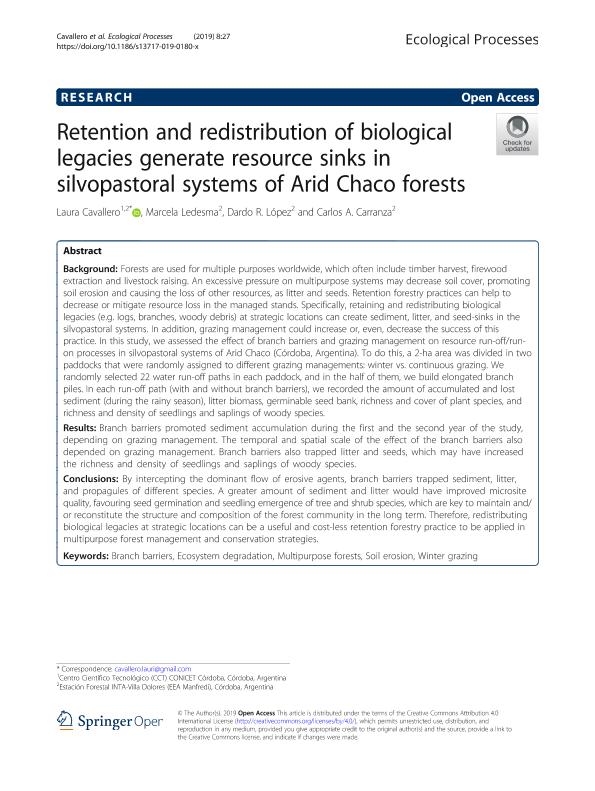Artículo
Retention and redistribution of biological legacies generate resource sinks in silvopastoral systems of Arid Chaco forests
Fecha de publicación:
11/07/2019
Editorial:
Springer Verlag Berlín
Revista:
Ecological Processes
e-ISSN:
2192-1709
Idioma:
Inglés
Tipo de recurso:
Artículo publicado
Clasificación temática:
Resumen
Background: Forests are used for multiple purposes worldwide, which often include timber harvest, firewood extraction and livestock raising. An excessive pressure on multipurpose systems may decrease soil cover, promoting soil erosion and causing the loss of other resources, as litter and seeds. Retention forestry practices can help to decrease or mitigate resource loss in the managed stands. Specifically, retaining and redistributing biological legacies (e.g. logs, branches, woody debris) at strategic locations can create sediment, litter, and seed-sinks in the silvopastoral systems. In addition, grazing management could increase or, even, decrease the success of this practice. In this study, we assessed the effect of branch barriers and grazing management on resource run-off/runon processes in silvopastoral systems of Arid Chaco (Córdoba, Argentina). To do this, a 2-ha area was divided in two paddocks that were randomly assigned to different grazing managements: winter vs. continuous grazing. We randomly selected 22 water run-off paths in each paddock, and in the half of them, we build elongated branch piles. In each run-off path (with and without branch barriers), we recorded the amount of accumulated and lost sediment (during the rainy season), litter biomass, germinable seed bank, richness and cover of plant species, and richness and density of seedlings and saplings of woody species. Results: Branch barriers promoted sediment accumulation during the first and the second year of the study, depending on grazing management. The temporal and spatial scale of the effect of the branch barriers also depended on grazing management. Branch barriers also trapped litter and seeds, which may have increased the richness and density of seedlings and saplings of woody species. Conclusions: By intercepting the dominant flow of erosive agents, branch barriers trapped sediment, litter, and propagules of different species. A greater amount of sediment and litter would have improved microsite quality, favouring seed germination and seedling emergence of tree and shrub species, which are key to maintain and/ or reconstitute the structure and composition of the forest community in the long term. Therefore, redistributing biological legacies at strategic locations can be a useful and cost-less retention forestry practice to be applied in multipurpose forest management and conservation strategies.
Archivos asociados
Licencia
Identificadores
Colecciones
Articulos(CCT - CORDOBA)
Articulos de CTRO.CIENTIFICO TECNOL.CONICET - CORDOBA
Articulos de CTRO.CIENTIFICO TECNOL.CONICET - CORDOBA
Citación
Cavallero, Laura; Ledesma, Marcela; López, Dardo Rubén; Carranza, Carlos Andrés; Retention and redistribution of biological legacies generate resource sinks in silvopastoral systems of Arid Chaco forests; Springer Verlag Berlín; Ecological Processes; 8; 27; 11-7-2019; 1-16
Compartir
Altmétricas




